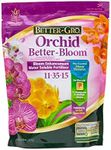Buying Guide for the Best Fertilizer For Orchids
Choosing the right fertilizer for your orchids is essential for healthy growth and beautiful blooms. Orchids have unique nutritional needs compared to other houseplants, so it's important to understand what to look for in a fertilizer. By focusing on a few key specifications, you can ensure your orchids get the nutrients they need without risking damage from overfeeding or the wrong nutrient balance.N-P-K RatioThe N-P-K ratio stands for Nitrogen (N), Phosphorus (P), and Potassium (K), which are the three main nutrients in fertilizers. This ratio tells you the percentage of each nutrient in the fertilizer. Nitrogen helps with leaf growth, phosphorus supports root and flower development, and potassium aids overall plant health. For orchids, a balanced or slightly higher phosphorus formula is often recommended, especially during blooming. If you want more leaves and growth, a higher nitrogen ratio is useful, while a higher phosphorus ratio is better for flowering. Choose a ratio based on whether your orchid is in a growth phase (more nitrogen) or a blooming phase (more phosphorus).
Fertilizer FormFertilizers come in different forms such as liquid, powder, or slow-release granules. Liquid fertilizers are easy to mix with water and provide quick results, making them ideal for regular feeding. Powders are similar but need to be dissolved before use. Slow-release granules are sprinkled on the soil and release nutrients over time, which is convenient if you prefer less frequent feeding. If you like to monitor and adjust feeding often, liquid or powder forms are best. If you want a low-maintenance option, slow-release granules are a good choice.
Urea ContentUrea is a common source of nitrogen in fertilizers, but orchids can be sensitive to it, especially when grown in bark-based media. Urea needs to be broken down by soil microbes before plants can use it, and this process is slower in orchid potting mixes. Look for fertilizers labeled as 'urea-free' or those that use nitrate or ammoniacal nitrogen instead. If your orchids are potted in bark or a soilless mix, choosing a urea-free fertilizer helps prevent nutrient deficiencies and root burn.
MicronutrientsBesides the main nutrients, orchids also need small amounts of micronutrients like magnesium, calcium, iron, and zinc. These help with various plant functions and prevent deficiencies that can cause yellowing leaves or poor growth. Some fertilizers include these micronutrients, while others do not. If you notice your orchid has pale leaves or weak growth, a fertilizer with added micronutrients can help. For most healthy orchids, a balanced fertilizer with micronutrients is a safe choice.
Frequency of ApplicationSome fertilizers are designed for weekly use, while others are meant for monthly or even less frequent application. The frequency depends on the strength of the fertilizer and the needs of your orchid. Orchids generally prefer weaker, more frequent feedings rather than strong, infrequent doses. If you have time to fertilize regularly, choose a product for weekly use at a diluted strength. If you prefer less frequent care, look for a fertilizer that is safe for monthly application.















